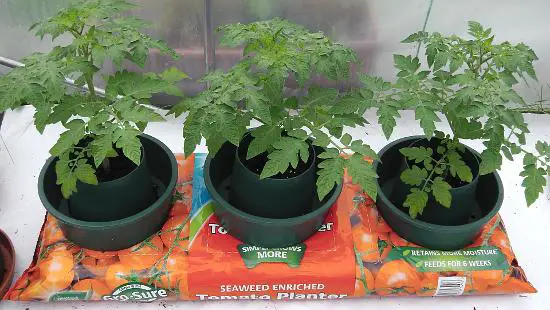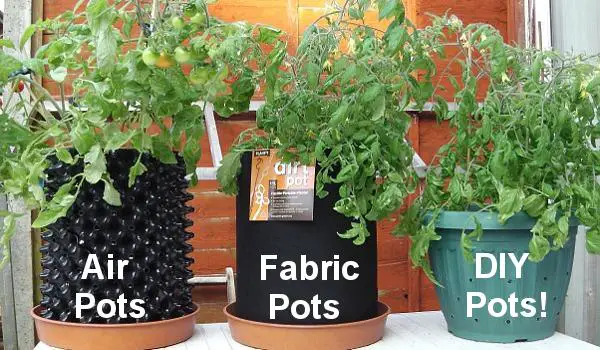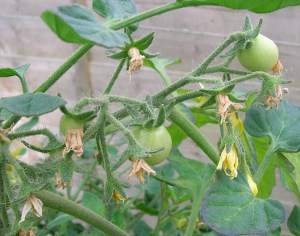Although the following Tomato Growing Tips mainly apply to UK growing, most are universal. They work in most situations where tomatoes are grown in the garden and greenhouse.

There are many different ways to grow tomatoes successfully and many different opinions on how to grow them!
Growing Tomatoes UK
In the UK we mainly grow tomatoes in containers and grow bags – the brave and experienced gardeners sometimes grow their tomatoes in their garden soil, or on an allotment.
In warmer climates, with longer growing seasons, tomatoes are often grown outside and directly in the garden (backyard) soil.
Whatever way you grow your tomatoes, the following tips should be helpful.
Tips For Sowing Tomato Seeds
- Sow seeds indoors for quickest germination.
- Use a propagator to create humidity inside the lid so that seed shells do not stick to the seed leaves.
- Keep tomato seedlings and young plants in as light an area as possible so they won’t become leggy.
Bush Varieties Do Not Need Their Side Shoots Removed
I’m sometimes asked, which bush, cherry variety would you recommend?
Here is a few that I’ve often grown, with good results.
Hanging Baskets – Trailing Varieties
Tumbling Tom is an excellent choice because it doesn’t become too leggy in low light conditions. As a trailing bush type, it does not require its side shoots removed.
Lizzano F1 and Terenzo F1 (sometimes called Tumbling Bella) are both new varieties and highly recommended.
Tumbler F1 is excellent!
Leggy means that a plant’s main stem becomes too tall too quickly because it is searching for light.
Large Pots and Containers
Red Alert and Maskotka have a more upright habit and need some support. However, any of the trailing varieties grow well in high sided pots and containers.
It is best to avoid grow bags when growing trailing tomatoes because you will want to avoid the slugs and snails at ground level.
Watering Seedlings
Try not to over water seedlings … compost should be just moist – not wet.
Watering young plants from below (in saucers and trays) is a good idea as it prevents the compost from becoming compacted from the weight of water from above.
However, roots need air too, so allow the soil to dry-out slightly before watering again. Think of watering as a wet/dry cycle.
- Pot seedlings into their own 3 inch (or just slightly bigger) pots at around three weeks after germination – when their first true leaves appear.
- Always use fresh compost because used compost may contain disease.
- Always sterilise pots and equipment that have come into contact with soil used to grow tomato plants in previous seasons – to avoid disease.
Avoid Frost
Plants cannot be left outside overnight until after your estimated last frost date.
Seeds are usually sown around two months before planting outside.
If your last frost is the end of May, sow the end of March.
Sowing earlier, the end of February, is fine if you have a greenhouse, but seedlings cannot be left outside in an unheated greenhouse until the beginning of May.
More information about greenhouse may be found here:
https://www.gardensite.co.uk/greenhouses/
Use New Potting or Multi-Purpose Compost for Containers
New compost already contains food for growth, so feeding is unnecessary until all the food in the compost has been used-up by a plant. Three to four weeks in a small pot – six weeks in a larger container or grow bag.
When To Feed Tomato Plants
No need to feed with tomato food until the first pea-like fruit appears (as below).
- Overfeeding young plants may cause root burn.
- N P K stands for nitrogen, phosphorus and potassium and are the three main ingredients (minerals) of plant food.
Low Temperature Affects Uptake of Minerals
Sometimes, plants suffer from mineral deficiency because their roots are too cold to absorb the food they need, even though the compost they are in contains plenty of food. This happens mainly in the cold springtime.
Stages of Growth In Tomato Plants
A tomato plant has three stages of growth:
- The leaf,
- The flower
- The fruitng stage
Each stage requires a different level and balance of nutrients.
However, it may also be said that there are two stages of growth:
- The Vegetative Stage
- The Productive Stage
In the two stages above, flowering and fruiting are both said to be part of the Productive Stage.
How long from seed to ripe tomatoes?
The average tomato plant takes around 4 months of growth in the UK to produce ripe tomatoes. That’s from sowing to picking.
If you choose a quick growing cherry variety, growing in the best conditions, it can take just over 3 months.
Plant Sizes…
Tall plants are called cordon or indeterminate
These require their side shoots removed – best grown in grow bags
Bush plants are also called determinate
They don’t require the removal of their side shoots – best grown in high sided pots and many trailing varieties can be grown in hanging baskets.
Be Safe With Cane Supports – Tomato Growing Tips!

Safety is an issue when using support canes. Attach a piece of heavy duty tape to the top of canes in order to see them more easily. Canes around three feet are the most dangerous … you bend down to look at your plants more closely and you could lose an eye if you don’t see the end of the cane!
Reduce Evaporation When Growing In Grow Bags
Keep the compost in grow bags completely covered in order to reduce moisture evaporation.
Make holes with a pencil at both ends of your grow bag. If you make holes in the middle of a grow bag, the water runs out before it has had a chance to moisten all the compost.

Growing In Pots & Final Pot Sizes
A good size to use would be around 12 to 15 litres. However, if you you use air pots or fabric pots that allow much more oxygen into the root zone, pot sizes can be reduced to around 10 litres, especially if perlite is added to the potting compost.
A 6 litre air pot is large enough for a trailing cherry variety if the growing medium is well aerated.

Wet Leaves Is An Issue
Try to provide some shelter from the rain even if you grow outside because tomato plants hate their leaves constantly wet. Wet leaves in cold conditions for more than a couple of days equals tomato blight.
Tomato blight is a fungal disease which is very destructive to plants and fruit.
Our anti-fungal, sprays, for vegetables, have been withdrawn from sale owing to EU regulations but we now have blight tolerant varieties such as Crimson Crush and Mountain Magic. These do a good job at resisting Tomato Blight!
Blossom End Rot
Blossom End Rot (BER) mainly affects medium and large size tomatoes. Brown leathery patches form at the bottom of fruit because not enough calcium has been absorbed when the fruit was swelling.

One way to help avoid blossom end rot is to apply Chempak Calcium. However, if you use good quality compost, water correctly and grow when the temperatures are suitable for tomato plants, you probably won’t need it.
The time that you may need extra calcium is when the weather is cold for a long period just before fruiting, or when the weather is very warm and your containers are drying out too quickly, making it difficult to keep your compost moist.
Large tomato varieties are also more prone to calcium deficiency and blossom end rot.
About Tomato Varieties – short season – cold tolerant
Choose short season varieties if you live in a cool season area such as the UK, like Red Alert.
Plant into a large container or grow bag, when growing outside, after the last frost in your area and preferably when the flower buds begin to open.
Some varieties are also cold tolerant such as Glacier. However, no tomato plant that I know of, is able to grow well if night temperatures drop below around 5 or 6C.
Hybrid F1 or Open Pollinated
Hybrid F1 varieties are first generation crosses of two other varieties and are also very vigorous.
Open-pollinated varieties grow “true to type” which means that they produce the same variety season after season. Tomato plants are self-pollinating.
Saving Tomato Seeds
You can save the seeds from open-pollinated varieties and grow the same tomatoes the following season. If you sow the seeds from a Hybrid F1, the seeds produce tomatoes with seeds that are F2’s. Unfortunately, these seeds are genetically unstable … they won’t produce tomatoes that are the same as their parents and you never know what you are going to get!
Companion Planting
French Marigolds and other bright blooms attract bees and other flying insects into the garden that help to pollinate the tomato flowers. Slugs and snails love marigolds and eat them first – before the tomatoes. They can have my marigolds but not my tomatoes!
Encouraging Flowers To Set Fruit
Spraying with a mist of water and shaking or tapping the plants gently helps to encourage pollination.
An electric toothbrush that vibrates also helps disturb pollen – hold it against the flowers.
Removing Leaves and Leaf Branches
De-leafing is the removal of lower leaves that are diseased or no longer of benefit to the well-being of a plant. Traditionally, it is common to remove leaf branches to the truss that has ripened. So when the first truss has ripened the leaves below can be removed and so on.
A Plant’s Health Is Usually Displayed In The Leaves
The health of a tomato plant is usually displayed in its leaves. Mineral deficiencies, fungal diseases and viruses are usually shown in leaves.
How To Ripen Green Tomatoes
To speed up ripening, put tomatoes in a bowl with a ripe banana. Ripe fruit – especially a banana – gives off the gas ethylene which encourages tomatoes to ripen.
Soil pH for Growing Tomatoes
Another consideration is soil pH – the acid to alkaline balance.
Tomato plants like this to be on the acid side at about 6.5 to 6.8 in soil (neutral is 7.0). The important thing about soil pH is that if it’s right, it will help plants absorb nutrients, if it’s wrong, it will prevent plants from absorbing the nutrients they need.
The Study Of Growing Tomatoes
It is possible to learn a lot about tomato plants and growing tomatoes but you can be very successful with just a little knowledge if you follow a few basic tomato growing tips this summer.
To Sum Up – Important Tips
- Plant seedlings into 3 inch pots three or four weeks after germination when the true leaves appear
- Pot on to larger pots to prevent young plants from becoming root-bound
- Use fresh multi-purpose compost to fill containers or use grow bags
- Plant outside after last frost in your area
- Do not feed with tomato food until pea-like fruit appear
- If you grow tall varieties outdoors, pinch out main stem above fourth or fifth truss if you are growing outdoors
- If you grow bush varieties, just leave them to do their thing!
.
See Also:
Frequently Asked Questions
Tips for Tomato Seedlings



